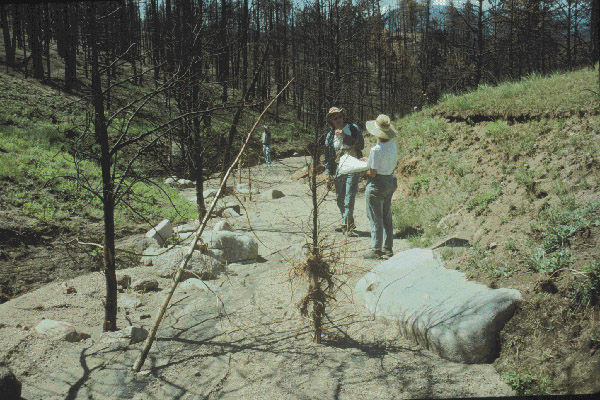Biogeochemical Implications of Event-Type Processes at the Hillslope to Small-Watershed ScaleRobert Stallard: Telephone: +1-303-541-3022; FAX: +1-303-447-2505 |  |
Biogeochemical Implications of Event-Type Processes at the Hillslope to Small-Watershed Scale
Robert Stallard: Telephone: +1-303-541-3022; FAX: +1-303-447-2505
e-mail: stallard@colorado.edu
(3) Biogeochemical Implications of Event-Type Processes at the Hillslope to Small-Watershed Scale: A variety of rare episodic phenomena that operate on the hillslope to small-watershed scale are capable of moving such large quantities of materials that they can substantially affect biogeochemical budgets for a landscape. Landslides and fire-flood sequences are such phenomena. Landslides in humid mountainous regions may dominate mass wasting on hillslopes. Long periods of quiescence and soil development end when an event such as heavy rain or an earthquake destabilizes soil thereby triggering a landslide. The export of partially weathered bedrock, the burial of organic matter in the slide, and the exposure of less weathered saprolite all strongly affect the biogeochemical cycles for many elements. Fire-flood sequences may be the dominant style of rapid erosion in forested, dry, montane regions. Fire-flood sequences require the development of vegetation that can sustain an extensive hot fire combined with suitable weather conditions. Burns often promote soil hydrophobicity that prevents infiltration. If a burn is followed be a large rain storm, the diminished infiltration results in highly erosive runoff and deep erosion. As with landslides, the export of partially weathered bedrock, the incorporation of charcoal and other organic matter into flood deposits, and the exposure of fresh bedrock can strongly affect biogeochemical cycles. Human activities have greatly influenced the size and frequency of these phenomena. The implication to biogeochemical cycles at a regional to global scale may be significant, but much research is needed. Moreover, these phenomena represent major hazards for people living in hazard-prone areas. Currently research is focused on landslides in eastern Puerto Rico and the Buffalo Creek Fire near Denver, Colorado. To fully understand the role of these phenomena, processes on landscapes that are not affected, by reason of flatness or plant cover are compared to affected landscapes.
Research into Fire-Related Erosion: Fire-flood sequences may be the dominant style of rapid erosion in many parts of the montane west and similar dry montane regions. In 1996 the Buffalo Creek Fire, near Denver, produced a spectacular fire-flood event. This event resulted in the rapid erosion of soil and charcoal, which were then dumped into three reservoirs that serve the Denver Water District. Deborah Martin (this project) and John Moody managed to obtain funds from Denver Water Board. Work is linked to the MBCP, to silicate weathering models at a landscape scale, and to WEBB work. After five years, erosion and hydrologic response appear to be dropping to background levels. Starting in May, 2000 a series of wildfires stuck the montane west. Using methods developed on Buffalo Creek, we have been heavily involved in three of these: the Cerro Grande Fire, near Los Alamos, NM, the Hi Meadows Fire, next to the Buffalo Creek Fire, and the Bobcat Fire, northwest of Denver. Work has been funded through DOI Cerro Grande funds and a Inter-Divisional USGS Venture Capital Grant, along with collaboration with researchers from many institutions. From the biogeochemical perspective, we are using beryllium-10 to examine wither contemporary fire-related erosion rates are greater than the long-term erosion rate. In addition we are hoping to identify suitable watersheds to compare the biogeochemistry of burned and non-burned watersheds on granitic bedrock.
Theory of Erosional-Event Biogeochemistry: Vegetation and weathering processes interact in ways that promote erosional events once some type of threshold has been crossed. We ask (1) what is the role of vegetation in event-style erosional phenomena? (2) What are the feedbacks that define where these erosional styles operate? And (3) what is the role of humans in modifying the effects of these phenomena? For fire-related erosion, burnable biomass must accumulate and a suitable combination of dry followed by wet weather must occur. Recurrence intervals are 10's to 100's of years. Landslides require a suitable accumulation of weathered soil, typically anchored by vegetation, and a triggering event such as major rainfall or earthquakes. Recurrence intervals are 1,000's to 10,000's of years. Landslides and fire are of considerable importance because of the large loss of life and property associated with these phenomena, and because of importance of human activities in affecting the triggering thresholds in ways that promote these phenomena. Soil avalanching (landslides in soil that has developed in situ from bedrock) has the capability of substantially increasing the long-term chemical weathering rates and sediment yields of a river basin. In particular, in humid settings on steep hillslopes, and on a time scale of thousands of years or greater, soil avalanching may accelerate atmospheric carbon-dioxide fixation as alkalinity produced by silicate weathering and as buried organic carbon.
Impact: Published work on event-related erosion has largely been of an applied nature for fires and landslides. The work on Beryllium-10 landslide erosion in Puerto Rico (Brown et al., 1995, 1998) has had a strong effect in a field where application of Be-10 had largely been for dating single past events. Fire-erosion publications and landslide hydrology publications are only being reviewed now.
Recent Research Efforts (to find out more, click on effort):
- Robert Stallard Home Page.
- Global-scale process research involving biogeochemistry and geomorphology with a focus on terrestrial sedimentation and the carbon cycle.
- Luquillo USGS Water, Energy, and Biogeochemical Budget (WEBB) Project in eastern Puerto Rico and parallel work in Panama.
- Biogeochemical implications of glacial erosion.
- The life cycle of the giant Amazon water lily.
- Intercomparison of soils, nutrients, and plants in forest-dynamics research plots of the global tropics.
- The Neotropical amphibian die-off (RANA)
.
Return to: http://spot.Colorado.EDU/~stallard/
This Home Page
University of Colorado.
US Geological Survey